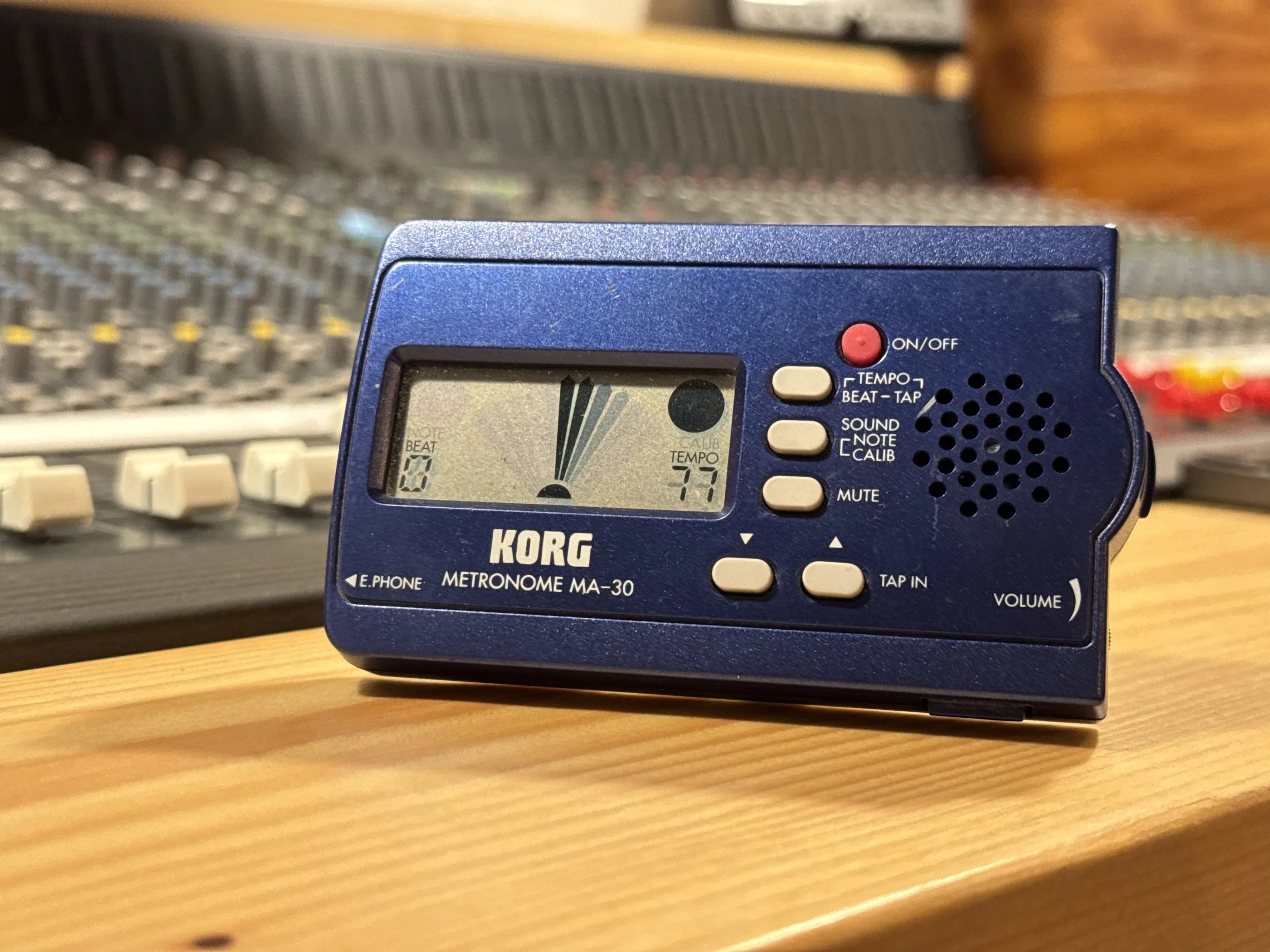The Click Track Dilemma: When to use it, When to let it go
Click Tracks & Metronomes: Do You Really Need Them?
After our last post digging into the big question of “Who are you creating for?” we figured we’d bring it down to something more grounded— but still something we keep talking about: click tracks and metronomes.
It’s come up in rehearsals, in the studio, even in those after-practice hangs. When do you use a click? Should you always use one? Is it helping— or just getting in the way?
What’s a click, really?
Let’s start simple. A metronome or click track is just a steady pulse— usually a series of beeps, clicks, or ticks— that keeps time. Some clicks are basic: just quarter notes, one sound, repeating forever. Others get fancy— accented downbeats, subdivisions, polyrhythms, swing feel. You can get deep if you want to.
And they can be used in all kinds of ways. Maybe only the drummer hears it. Maybe the whole band does. Sometimes it’s piped into in-ear monitors, other times it’s just a phone app on a practice amp. In a recording session, it can be critical— or totally unnecessary.
Some music needs a click
Certain types of music— especially dance, electronic, pop, or hip-hop— pretty much live on a grid. You’ve got layers of parts being built, chopped, moved around. A click track keeps everything aligned. It makes editing cleaner, syncing easier, and transitions tighter.
And if you're tracking in stages (say, recording drums after guitars or vocals), having a click is usually what makes that possible.
Some music really doesn’t
But then you’ve got songs that breathe. Songs that pull back in the verse and push forward in the chorus. Songs that rely on feel, not precision.
Ever listened to "Honky Tonk Women" by The Rolling Stones? The tempo shifts throughout— sometimes it speeds up a bit, sometimes it drags just enough to feel loose and groovy. That wouldn’t happen with a click. And it’s part of what makes that song what it is.
Or take "Bohemian Rhapsody" by Queen. Its varying tempos — moving from ballad to opera to hard rock — were never locked to a click, allowing for a more fluid, organic feel. This freedom is a key part of what gives the song its dynamic flow and emotional punch.
Think of artists like Nina Simone, The Band, or even James Brown— who famously used no click but had incredible internal time. These artists used tempo like another instrument, not just a container for rhythm.
But metronomes aren’t the enemy
We’re not here to bash metronomes. Far from it. They’re one of the most valuable tools a musician can have.
If you’re working on your timing, tightening up your groove, or learning to subdivide beats, a metronome will tell you the truth. It’ll call you out. It’ll humble you. (We’ve all had that moment of thinking we were in the pocket… only to find out we were rushing.)
Practicing with a click teaches you how to feel the beat, not just count it. Start with straight quarter notes. Then try turning the click into just beat 2 and 4. Then just 1. Then none at all—just feel it and come back to check in. That’s how you build internal time.
Real talk: the click isn’t right for every artist — and that’s totally okay.
For some musicians, a click track can feel limiting. It might stiffen the groove or flatten the emotional flow of a performance. For others, it’s a helpful anchor that brings focus and cohesion.
It’s not about right or wrong — it’s about what serves the song, the players, and the moment.
We’ve had sessions where the click made everything tighter and smoother. And we’ve had others where it drained the energy, so we turned it off after one take.
So… when was the first click track?
Historically speaking, the click track showed up in film scoring first. Carl Stalling used one back in the 1930s for animated cartoons— so music and visuals could sync up perfectly.
It wasn’t until the rise of multitrack recording in the ‘60s and ‘70s that clicks became common in the studio. Drum machines, digital audio workstations, and the growing demand for “tight” productions made them a default.
But even now, not every session uses one. And not every great record needs one.
Want to practice with a metronome?
There are a bunch of great tools out there now:
Soundbrenner – sleek, customizable, and even wearable if you’re into that.
Tempo Advance (iOS) – great for complex subdivisions and tempo changes.
TonalEnergy – part tuner, part metronome, part Swiss army knife for musicians.
You can also just start with a simple free app or an old-school analog metronome. Whatever helps you get tighter.
Your groove, your rules.
As musicians, we work in time as much as we work in sound. The click track is one way to shape that time— but it’s not the only way.
Use it when it helps. Ignore it when it doesn’t. Trust your ears, trust your body, trust the people you’re playing with. A great groove can come from a metronome— but it can also come from a shared look across the stage, a deep breath before the downbeat, or a little push-and-pull that only happens in real time.
So the next time someone asks “Should we use a click?”, the real answer is: it depends.
Just make sure it’s your choice.
Interested in recording?
Want to share your own love/hate relationship with the click? Or have a great example of a track that breathes beautifully without one? Drop it in the comments or DM us— we’re always listening.

